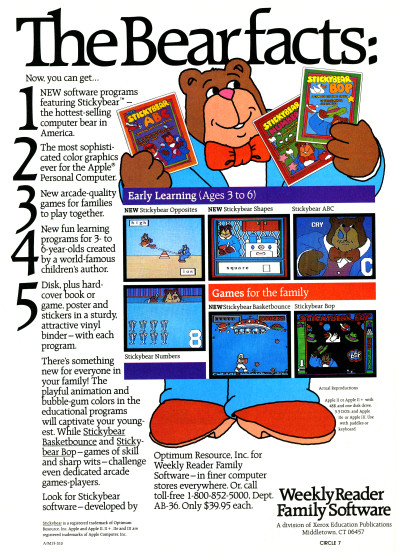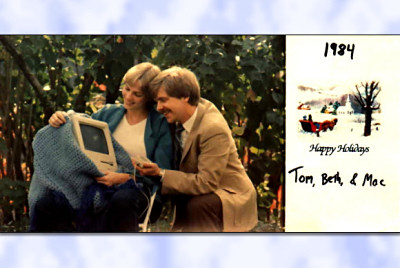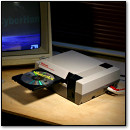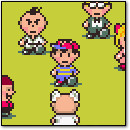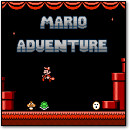[ Retro Scan of the Week ] Hand-Drawn Golf Reference
Monday, June 3rd, 2013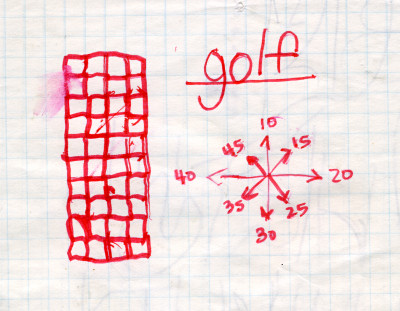 If there were only 40 degrees in a circle, this is what it would look like.
If there were only 40 degrees in a circle, this is what it would look like.
There is a certain rustic beauty in hand-drawn video game notes that I will never cease to enjoy. Case in point: this map/reference key created by family friend Chris when he was a kid in the 1980s. I’m not quite sure what game it was for (other than “Golf”), but it was likely a game for the Apple IIc, as I found it among related Apple IIc ephemera when I acquired his collection some years ago.
For more hand-drawn video game goodness, check out this VC&G post about my friend’s Deadly Towers maps from 2006.
[ Update: 06/03/2013 – I was just talking to my brother, and he thinks that either he drew this alone or I wrote the letters and he drew the numbers. It was either a reference to a Golf game he programmed in C in 1991, or an old Atari 800 golf game that I haven’t found yet. I still think it’s possible that Chris wrote the letters. ]
Discussion Topic of the Week: Do you ever hand-draw maps for modern video games?
[ Retro Scan of the Week ] Star Dot Matrix Printer
Monday, April 8th, 2013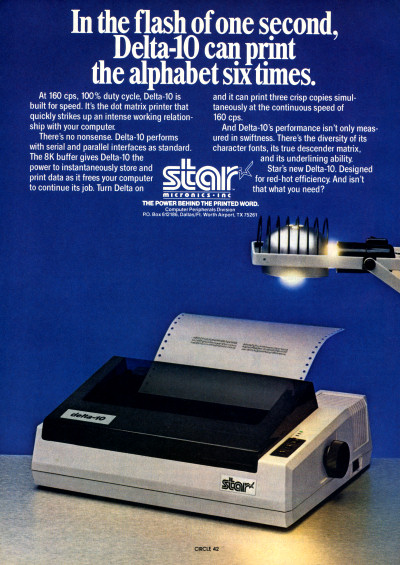 The Star Micronics Delta-10 Dot Matrix Printer: Mouse with Machine Gun
The Star Micronics Delta-10 Dot Matrix Printer: Mouse with Machine Gun
My family owned this exact printer. In fact, I think it’s still sitting in my parents’ attic as we speak. If I’m not mistaken, we used it with our Apple IIe system — the one my dad built from a bare circuit board and a set of cloned ROM chips (much like the one in this 2006 VC&G post).
It’s probably the first printer I ever saw in action, likely before I could even walk. I can recall crawling under our computer desk (the printer was on the floor beneath it for some reason) and watching it print out whimsical banners and calendars from a program like Broderbund’s The Print Shop.
But what I remember most about it, of course, was the sound it made: like a screeching robot mouse spraying lead into tractor-feed paper with a tiny machine gun. Like any dot matrix printer, once you hear one in action, the sound will never leave you.
Those were the days.
Of course, I was still using a dot matrix printer until the early 1990s, so I am pretty much scarred for life. Mice everywhere.
Discussion Topic of the Week: What was the first printer you ever owned?
[ Retro Scan of the Week ] Apple II Box for C64
Monday, March 25th, 2013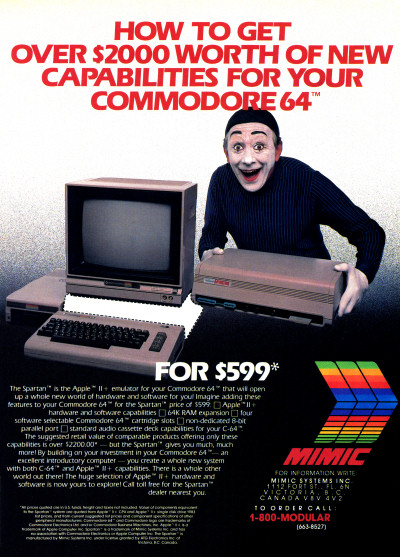 A scene from one of Benj’s recent nightmares.
A scene from one of Benj’s recent nightmares.
Hey mime! Yeah, you! Stop stealing my $599 Mimic Spartan Apple II+ compatibility box for the Commodore 64. I need it to open up a whole new world of hardware and software.
Just for a second, imagine if I could add these features to my Commodore 64: Apple II+ hardware and software capabilities, 64K RAM expansion, four software selectable Commodore 64 cartridge slots, non-dedicated 8-bit parallel port, and standard audio cassette deck capabilities for my C-64. Yep, all of that!
The suggested retail value of comparable products offering only these capabilities is over $2,200.00*. But the Spartan gives me much, much more, mime! Oh yes. By building on my investment in my Commodore 64 — an excellent introductory computer — I create a whole new system with both C-64 an Apple II+ capabilities.
There is a whole other world out there! And if you’d just give it back, a huge selection of Apple II+ hardware and software would be mine to explore. Call toll free for the Spartan dealer nearest you.
* Burp.
Discussion Topic of the Week: Open Discussion: Whoever posts a question first gets to decide what we’ll talk about this week.
—
See Also: MacCharlie’s FrankenMac (2013)
Benj’s Macworld and TechHive History Roundup
Saturday, March 23rd, 2013

I last updated you on my Macworld work back in January. Since then, I’ve been busy writing more historically-minded pieces for the site as well as its sister site, TechHive. Below you’ll find a list of the ones I haven’t mentioned yet on this blog in convenient digest form.
- 01-30-2013- The Little-Known Apple Lisa: Five Quirks and Oddities
- 02-08-2013 – The History of Electronic Board Games
- 02-11-2013 – The Mac Color Classic, 20 Years Later
- 02-16-2013 – Abandoned Apples
- 02-18-2013 – Evolution of the Smartwatch
- 03-01-2013 – The Evolution of Apple Pointing Devices
- 03-15-2013 – Teach Your Old iPod New Tricks
- 03-22-2013 – Apple’s Five Most Important Displays
Phew. I’ve been busy! Of those eight pieces, the Apple Lisa one can’t be missed. Plenty of interesting little-known history there. The Mac Color Classic and Abandoned Apples pieces are some of my favorites as well.
I’m not sure, but I get the feeling from the lack of comments on my Apple-related posts that not many Apple or Mac fans visit VC&G. Not quite sure why that is, but if you’re out there, let me know.
[ Retro Scan of the Week ] African American Apple Fans
Monday, February 4th, 2013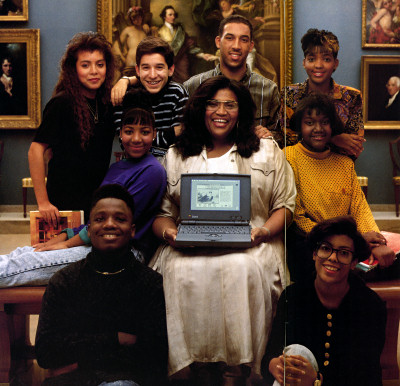 One big happy family — and a PowerBook (click to see entire ad)
One big happy family — and a PowerBook (click to see entire ad)
It’s Black History Month once again in the US, so I thought it would be timely to share this Apple PowerBook advertisement from 1992.
The ad appeared in the February issue of Smithsonian Magazine; I don’t think it is a coincidence that it prominently featured people of African descent. It also prominently featured the PowerBook 100, which had just been introduced a few months prior in October 1991.
The obvious racial focus of this ad brings to my mind a couple of interesting, if racially-charged questions: What percentage of black Americans, historically, have used Apple products versus other computer brands? Do African Americans, like other demographic groups, have their computer or tech brands of choice?
Today, Apple is such a mainstream company that the answer to the first question is most certainly larger than it likely was in the pre-iPod era. It would be interesting from a cultural standpoint to peek back into private demographic customer studies that Apple no doubt commissioned at various points in its history.
As for an answer to the second question, I have no idea. But I would love to hear from African American computer users to find out.
Discussion Topic of the Week: What’s your favorite PowerBook model?
[ Retro Scan of the Week ] Apple Lisa and Apple IIe
Monday, January 21st, 2013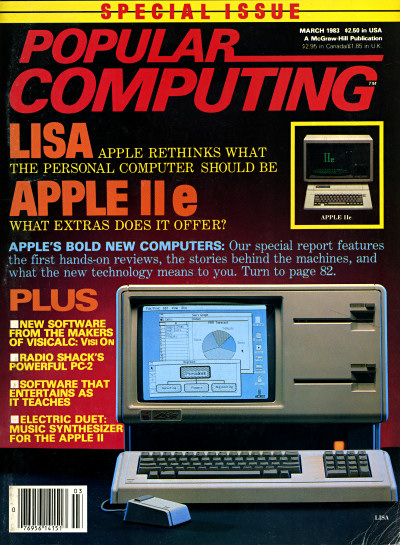 APPLE’S BOLD NEW COMPUTERS IN ALL-CAPS
APPLE’S BOLD NEW COMPUTERS IN ALL-CAPS
Thirty years ago last Saturday (January 19th, 1983), Apple announced two new computers: the Apple Lisa and the Apple IIe.
Ultimately, the Apple Lisa met an early end, leaving behind technology that shaped the entire industry. The Apple IIe remained a reliable breadwinner during uncertain times in the early life of the Macintosh and remained the flagship member of Apple’s popular 8-bit computer line until it ended in 1993.
Here’s the cover of the March 1983 issue of Popular Computing which featured Apple’s two new machines. It has always been one of my favorite vintage computer magazine covers.
By the way, I recently wrote an article about this anniversary for Macworld in case you’re interested.
Discussion Topic of the Week: Have you ever used an Apple Lisa? What did you think about it?
[ Retro GIF of the Week ] The Smithsonian’s Apple I
Friday, January 18th, 2013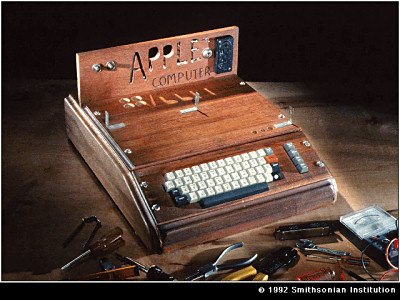 Click to see other views of this image: [ Original Size ] [ 2X Zoom ]
Click to see other views of this image: [ Original Size ] [ 2X Zoom ]
You’re looking at a photograph of an Apple I computer that currently resides in the collection of the Smithsonian Institute in Washington, D.C. It was on display at one point, but I believe it is not being displayed at the moment (feel free to correct me on that).
I downloaded this 256-color GIF image from CompuServe back in 1994 (judging by the file date). I think it came from the Archive Photos forum, but I am not 100% sure about that. Either way, it’s a nice photo, and if you see it floating around the Internet, it’s likely because I first posted it on VC&G in 2006.
As you may know the Apple I (which was officially titled “Apple Computer 1” on the circuit board and “Apple-1” in its manual) did not ship with a case. The wooden enclosure you see here was created by early Apple employee Randy Wigginton’s father. It’s interesting how it presages the design of the Apple II enclosure to some extent.
| Retro GIF of the Week Fact Box | |
| Source File Name: | APPLEI.GIF |
| Source File Date: | August 20, 1994 |
| Source File Format: | GIF – 89a (non-interlaced) |
| Dimensions: | 640 x 480 pixels |
| Color Depth (bits per pixel): |
8-bit (256 color) |
| Origin Platform: | Unknown |
| Derived From: | Scanned photograph |
| Creation Date: | 1992 |
| Artist: | Smithsonian Institute |
| If you know more about the origin of this image, please leave a comment. | |
[ Retro Scan of the Week ] MacCharlie’s FrankenMac
Monday, January 14th, 2013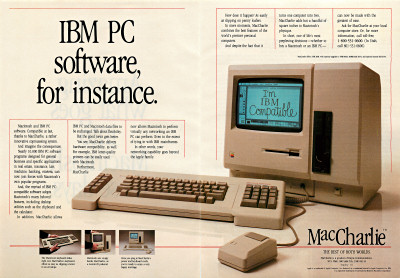 I’d like to have heard Steve Jobs’ reaction when he first saw this.
I’d like to have heard Steve Jobs’ reaction when he first saw this.
Long before Boot Camp and Parallels, if you wanted to run IBM PC compatible software on your Mac, you had to strap on this unholy contraption — the Dayna Communications MacCharlie.
If I recall correctly, the MacCharlie was essentially an IBM PC clone in a beige box that hooked to the Mac’s serial port. As a result, the Mac merely served as a serial terminal for the MacCharlie via custom terminal software running on the Mac. That’s not a particularly efficient setup, but the lack of expansion ports on the original Macintosh meant that there was no other reasonable point of entry.
Since it worked through the serial port, the MacCharlie could only run text-based MS-DOS applications. Conveniently, the MacCharlie shipped with a keyboard extender that added the IBM PC’s special function keys and a numeric keypad to the Macintosh keyboard.
Discussion Topic of the Week: Have you ever used a hardware system adapter (something that lets you use software from one platform on another through hardware, not software emulation) for any computer system?
Vintage Mac Christmas Art
Monday, December 24th, 2012Just in time for Christmas: Macworld has posted a slideshow of vintage Christmas-related Macintosh art and ephemera that I created for that site. I hope you enjoy it.
